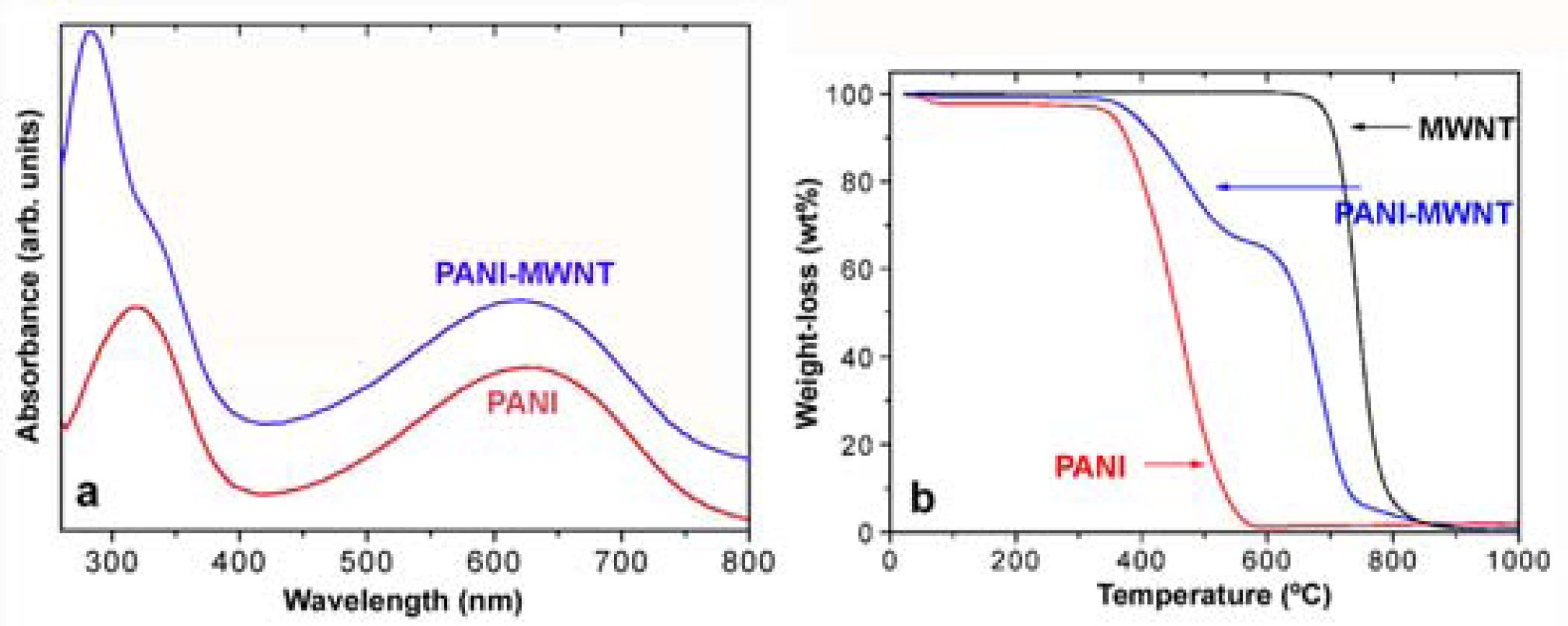Making smart materials using electroactive polymers and carbon nanotubes
عمل لدائن ذكية موصلة للكهرباء من البوليمرات والانابيب النانوية الكاربونية
هذا النص الانكليزي للمقال وساترجمة لكم لاحقا لتتحقق الفائدة للجميع
Wolfgang Maser, M. Teresa Martinez, and Ana M. Benito
In-situ polymerization methods can be used to fabricate highly functional composite materials for applications ranging from flexible electronic devices to wearable e-textiles.
11 December 2007, SPIE Newsroom. DOI: 10.1117/2.1200702.0930
Novel communication platforms such as e-papers and e-textiles offer instant information and data handling access. These electronic platforms are based on smart materials that can recognize, process, and respond to external stimuli. They are also easy to manipulate and can be applied on surfaces of various types and shapes. Electroactive or intrinsically conducting polymers1 such as polyaniline, polythiophene, or polypyrrole that combine the electrical conductivity of a metal with the mechanical flexibility and processing properties of a polymer, hold great promise as smart materials for flexible plastic and wearable electronics.2 Unfortunately, degradation issues resulting from their low environmental, thermal, and electronic stability, as well as processing problems, affect their reliability and long-term operational functionality.
To address these issues and improve their overall properties, novel nanoscale concepts aimed at adding functionality at the molecular level have generated significant interest. In this context, combining electroactive polymers with carbon nanotubes (CNTs) represents an attractive solution. These materials consist of tiny graphene cylinders of nanometer diameter and micrometer length with unique structural, mechanical, thermal, electronic and optical properties.3 However, simple mixing procedures usually fail to yield homogeneous and stable CNT dispersions, thus hindering effective interactions as well as further material processing.
To overcome these problems, we used an in-situ approach in which the polymerization of the electroactive polymer was carried out in the presence of CNTs.4–6 The technique is based on the idea that the extended π-electron system of CNTs can serve as molecular templates to direct the growth of the polymer chains along the nanotubes. This is particularly advantageous for promoting favorable interactions between both constituents and improving material functionality and processing quality.
Our starting material was polyaniline (PANI), a typical member of the electroactive polymer family. The in-situ polymerization process is depicted in Figure 1. To our surprise, the product composite contained about 50 wt% of multiwall nanotubes (MWNTs), and could be completely dispersed in the highly polar solvent n-methylpyrrolidinone (NMP). We obtained the stable polyaniline-nanotube dispersion shown in Figure 2 which proved easy to process further.

Figure 1. In-situ polymerization process for a polyaniline multi-walled carbon nanotude (MWNT) composite. Polyaniline is first obtained in the emeraldine salt form, which is conducting but not soluble. Subsequent deprotonation with ammonium hydroxide transforms the emeraldine salt into the emeraldine base form (which is not conducting but soluble).

Figure 2. Blue polyaniline nanotube composite dispersion (a) which can be processed onto textile surfaces (b), free-standing films (c) and fibers (d).
The UV-vis spectrum (see Figure 3a) of the composite dispersion and the thermogravimetric analysis of the solid composite clearly revealed the existence of an additional, more planar, form of polyaniline covering the CNTs, which was responsible for the higher thermal stability of the whole composite (see Figure 3b). We also observed a drastic enhancement of the electrical conductivity (see Figure 4a), dominated by the percolated network of nanotubes in the composite. Quite remarkably, the high conductivity did not quench the luminescent properties of the composite (Figure 4b). Finally, despite the presence of nanotubes, we could also make the composite optically active, as shown in Figure 4c.7 More importantly, the presence of straight MWNTs also significantly prevented dedoping due to effective charge-transfer processes.

Figure 3. UV-Vis spectra of the polyaniline multi-walled carbon nanotude (PANI-MWNT) composite dispersion (a) with maximum absorption at 283nm indicative of effective interaction between the nanotubes and the more planar polyaniline; thermogravimetric analysis (b) confirming the 200°C higher thermal stability of the composite. Adapted from reference 5.

Figure 4. Electrical conductivity (a), photoluminescence (b) and circular dichroism (c) data showing the enhanced functionality of the polyaniline multi-walled carbon nanotube (PANI-MWNT) composite. Adapted from references 6 and 7.
Our in-situ polymerization approach allowed us to obtain highly favorable interactions between the electroactive polymer chains and the CNTs, resulting in a highly functional and completely soluble composite. The material shows enhanced conductivity, as well as improved thermal and deprotonation stability. It is also luminescent, optically active and can be processed from solutions into coatings, films and fibers. We believe that these materials provide a good basis for further advances in flexible electronic devices such as plastic circuits, solar cells, organic light-emitting diodes, and wearable e-textiles. We currently seek to explore these possibilities.
This work was supported by a grant from the Ministry of Education and Science of Spain (MAT 2006 13167-C02-02), by a grant from the Regional Government of Aragon DGA (PIP021/2005), and by the DGA program Grupo Consolidado (G-CNN).
Wolfgang Maser, M. Teresa Martínez, Ana M. Benito
Department of Nanotechnology
Institute of Carbon Chemistry
Spanish National Research Council
Zaragoza, Spain
http://www.icb.csic.es/g-cnn/
Wolfgang Maser, M. Teresa Martínez, and Ana M. Benito are Spanish National Research Council staff scientists at the Institute of Carbon Chemistry. For over 10 years, they have been working in the field of carbon nanotubes, from production to application aspects. They have published more than 100 papers in this field. Their current research interests are focused on novel carbon nanotubes composite materials.
References:
1. A. G. MacDiarmid, Synthetic metals: A novel role for organic polymers, Angew. Chem. Int. Ed. 40, no. 14, pp. 2581-2590, 2001.
2. G. G. Wallace, G. M. Spinks, L. A. P. Kane-Maguire, P. R. Teasdale, Conductive Electroactive Polymers Intelligent Materials Systems, CRC Press, Boca Raton, 2003.












» رمضان مبارك
» اقتراح للادارة !!
» سلام خاص الى استاذي الغالي
» نظائر الكلور
» الصداقة الحقيقية
» الابتسامة وفوائدها
» العمليات الكيميائية لاستخلاص غاز الكلور
» هل تعلم